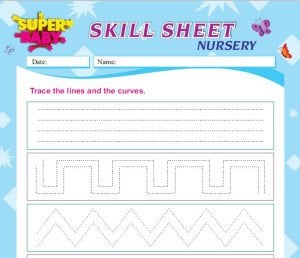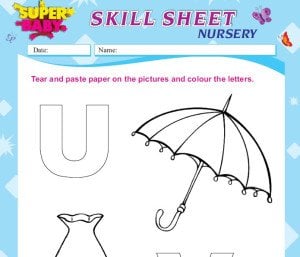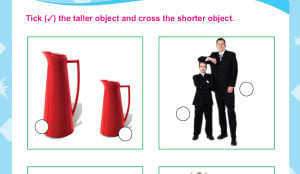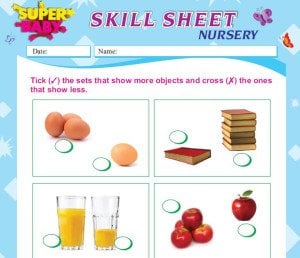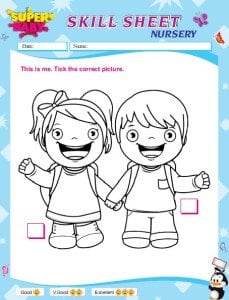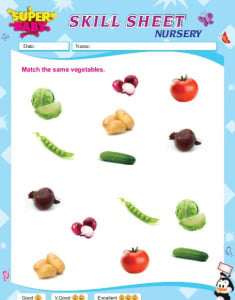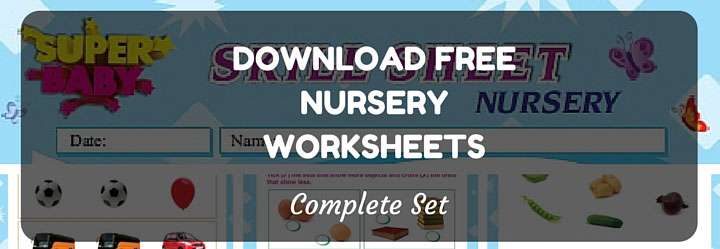NURSERY WORKSHEETS IN INDIA
>>> FREE DOWNLOAD: COMPLETE SET OF NURSERY WORKSHEETS <<
The complete set of Nursery Worksheets in India based on all syllabus and boards (CBSE, ICSE, ISE SSC, Cambridge etc).
PART 1
Consists of:
- Dotted lines of various sizes, shapes, patterns and curves. Your child has to connect the dots as accurately as possible with a pencil. It is also better to encourage him/her to connect the dots without a pause in between rather than with short interruptions.
- Outlines of objects that have to be DABBED WITH COTTON. The objects are accompanied with the corresponding starting alphabet. These alphabets have to be covered by a colour of your child’s choice.
- A letter and its corresponding are presented in a prominent manner. Your child has to circle multiple instances of the same letter given in the box below.
- Your child circling the first letter in the name of the corresponding object.
- Your child FINGER PRINTING an object as well as colouring the first letter in the name of that object. Finger printing involves your child using his/her finger to colour the object in various shades.
- 2 columns filled with letters placed in a random order. Your child has to MATCH A LETTER in the left column with its identical version in the right column.
- 2 columns filled with letters in the left column and different pictures (of objects, animals etc.) in the right column. Your child has to match the first letter of the name of a particular picture with the correct letter in the left column.
- 2 pictures and 2 letters. Your child has to PASTE PIECES OF PAPER on the pictures and colour the letters.
- 2 columns with letters on the left and pictures on the right. Your child has to match the first letter of the names of the pictures with the appropriate letters on the right.
- An incomplete picture. Your child has to complete the picture by connecting the dots from ‘A’ to ‘Z’ with a pencil. After connecting all the dots in the appropriate order, he/she should then colour the picture.
- Letters from ‘A’ to ‘Z’ in the form of dots. Your child has to CONNECT THE DOTS with a pencil leading to fully formed letters. Once that is done, he/she should attempt to write all the letters again…this time without the connecting dots.
- Tom & Jerry being separated by ‘A’ to ‘Z’. Your child has to connect the letters in the correct sequence to help Tom reach Jerry.
- Two pictures and two letters in a row. The names of both pictures start with the same letter. Your child has to look at both of the pictures and identify the correct letter that they begin with.
>>> FREE DOWNLOAD: COMPLETE SET OF NURSERY WORKSHEETS <<
PART 2
- Pictures of various objects. Each object has a twin that is on display as well. Your child is required to identify and tick the identical objects or twins.
- A box and a bunch of pictures displaying various objects found in the world. THE LARGEST object found in the environment has to be connected to the box by your child with a pencil.
- SHORT AND TALLER versions of certain objects. The respective short versions have to be crossed and the respective taller versions have to be ticked by your child with a pencil.
- 2 sets of the same object varying in quantity. The set of objects that have a larger quantity have to be ticked and the smaller quantity has to be crossed by your child.
- An incomplete structure made up of sequential dots. Your child has to connect all the dots in an appropriate manner and then colour the structure.
- Various shapes in varying colours. Your child has to IDENTIFY all the rectangles present and circle them with a pencil.
- 2 columns of snails with a number written on their shells. Your child has to MATCH THE NUMBERS that are identical in both columns.
- Numbers from ‘1-5’ in unconnected dots. These dots have to be connected in an appropriate manner by your child.
- A number and a bunch of identical objects. The number has to be understood and the appropriate number of objects have to be circled by your child.
- A number and a group of identical objects. The number has to be understood and the appropriate number of objects have to be coloured by your child.
- 2 columns. One column contains numbers and the second column contains a group of objects in varying quantities. Your child has to match the number with the appropriate quantity of objects.
- Numbers from ‘6-10’ in unconnected dots. These dots have to be connected in an appropriate manner by your child.
- 2 columns. The column on the left contains identical objects of varying quantity and column on the right contains 3 different numerical values. Your child’s task is to count the number of identical objects and match it to the appropriate numerical value on the right.
- An incomplete picture with various dots marked by numbers in a sequence. Your child’s task is to connect the dots in the correct sequence with the aim of completing the picture. Once the picture has been completed, he/she has to colour it.
>>> FREE DOWNLOAD: COMPLETE SET OF NURSERY WORKSHEETS <<
PART 3
- A boy & a girl. Your child has to tick his/her own GENDER.
- A boy and various parts of a body that are presented individually. The parts have to be matched with the correct PART OF THE BOY’S BODY by your child.
- 6 body parts and their usage during various activities. Your child’s task is to match the body parts with the appropriate activity during which they are used.
- A family tree. Your child has to paste the pictures of the specified relatives in the appropriate spaces provided.
- Various objects that are found in most homes. Your child’s task is to circle the objects that are only found in a kitchen.
- A variety of FRUITS. Your child has to tick the type of fruits she/he likes to eat.
- An outline of 3 fruits. Your child’s task is to identify them and then colour the fruit(s) that are red in colour.
- A pair of various VEGETABLES placed in random order. Every vegetable has to be matched with its identical twin by your child.
- A group of vegetables and fruits. Your child has to identify between the 2 types of food. Once the identification is done, she/he has to tick the fruits and cross out the vegetables.
- Outline of 4 types of vegetables. Your child’s task is to identify them and then colour the ones that are green in colour.
- Different ANIMALS. Once the identification is done, only the domestic animals found in everyday life have to be ticked by your child.
- An outline of 2 animals. Your child has to identify the 2 and then colour the animal that is found in a forest or a jungle.
- A variety of animals. Your child’s task is to tick the domestic animals and cross out the wild animals
- A variety of animals. Those animals that can be kept as pets at home have to be circled by your child.
- Adult and infant versions of different animals. Your child’s task is to match the adult animal with its appropriate infant version.
- 2 columns. The column on the left contains different animals and one on the right contains the appropriate animal homes. The animals have to be taken to their correct homes by your child.
- A flower. Your child’s task is to colour it.
- A variety of VEHICLES used in transportation. Your child has to tick the vehicles on which she/he has travelled by.
- A variety of BIRDS. Your child’s task is to tick the birds that she/he sees in everyday life.
- An outline of a butterfly. Pieces of paper with various colours have to be torn and pasted on the outline of the butterfly by your child.
>>> FREE DOWNLOAD: COMPLETE SET OF NURSERY WORKSHEETS <<
BENEFITS:
Connecting dotted lines teaches your child the meaning of a sequence and LOGICAL CONNECTIONS. An infant might struggle, but as she/he gets older, completing a dotted lines exercise without any help creates a lot of confidence in her/his own abilities.
Dot-to-dot activities are a great way to improve your child’s HAND-EYE CO-ORDINATION. A lot of concentration is required to complete these exercises accurately. The quality of visual motor work improves significantly.
Dot-to-dot activities are a valuable pre-writing teaching tool. Your child learns about the various WAYS IN WHICH TO GRIP A PENCIL, create shapes, focus and learn about the amount of pressure needed to apply.
Working on dot-to-dot activities is a fantastic way to STRENGTHEN HAND AND FINGER MUSCLES in preparation for writing. Early childhood is the optimal time to develop vital muscles for a lifetime of efficient use. These finger muscles form the most vital component of fine motor skills.
Completing dot-to-dot activities show the benefit of hard work to your child. Concentration and focus are built slowly by working on these activities.
By finger printing or painting an object, your child gains an informal education in mixing and exploring various colours. This activity involves all the senses: seeing, hearing, touching, smelling and (if your child likes the paint too much) tasting!
Finger painting also strengthens the finger and hand muscles, hand-eye co-ordination as well as promoting your child’s self expression, creativity and imagination. Such socio-emotional skills are vital to form a well-rounded individual as your child grows.
Finger printing is also therapeutic as it involves your child EXPRESSING HER/HIS FEELING WITHOUT SPEAKING. If the paper is placed on the floor, your child’s large muscle control and balance is also improved.
Tearing and pasting pieces of cotton or paper helps in making precise hand movements. Such activities help in motor skills development.
After pasting, painting is usually an activity that follows. Painting helps your child get used to holding a writing tool the correct way and aids in developing fine motor skills.
Painting various objects helps your child to plan as they decide the kind of colours to use.
Colouring simple pages helps your child in recognizing colour, hue, line, shape, perspective and form. Seeing and recognizing patterns plays a vital role in education and career. These abilities have to be finely honed from a young age.
Matching objects with their first letters or circling the right picture act as the first steps in identifying a thing with a word or an alphabet. Such visualization skills are vital to expand your child’s perception and way of thinking.
Distinguishing between taller or short versions, similar or different objects, varying quantities of similar object etc. only expand their knowledge on units of measurement, opposites and sizes.
The activities have also been designed to make your child observe around her/him a little more closely as well as posing a challenge to their LOGIC AND INTELLECTUAL SKILLS. The kind of objects available in a kitchen, the kinds of homes for different animals etc. act as the building blocks for observing the environment.
Your child’s knowledge of alphabets, numbers, shapes and colours are also constantly reinforced while going through these activities.
By going through the words and descriptions, your child’s VOCABULARY is also bound to grow exponentially. The various questions that arise while doing these activities only provide more opportunities to learn new words.
Finally, your little one’s appreciation and respect for the environment can only develop through knowledge. The exposure to different fruits, vegetables, birds, animals and their babies is bound to have a positive effect on a young mind.
